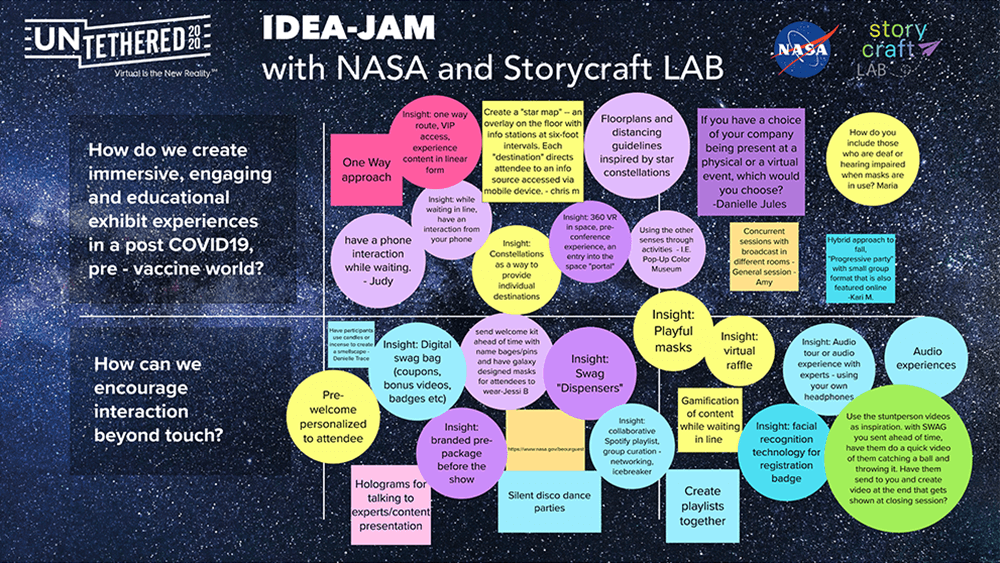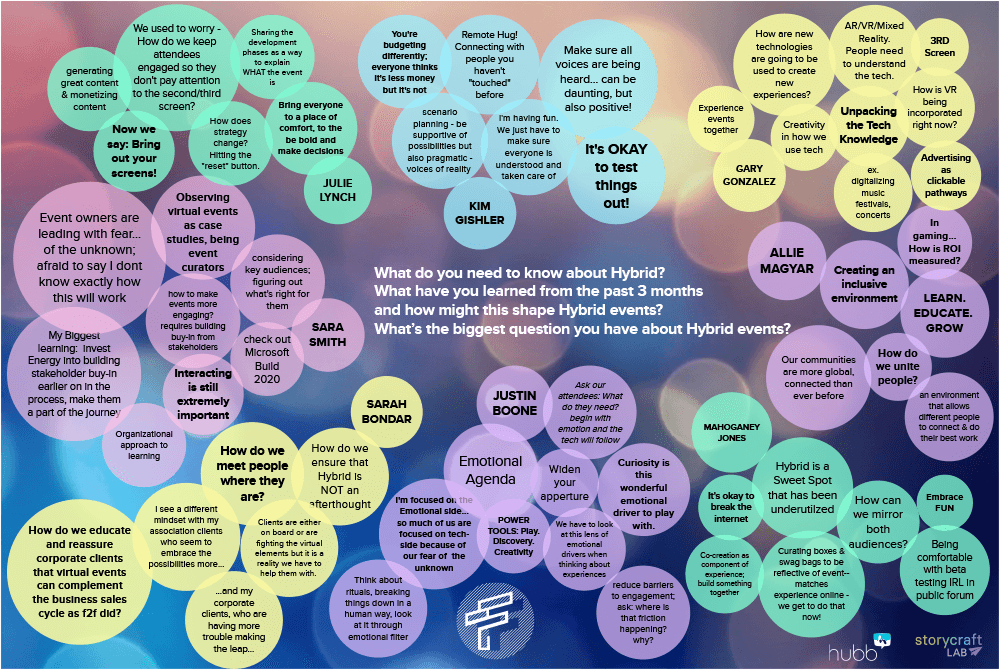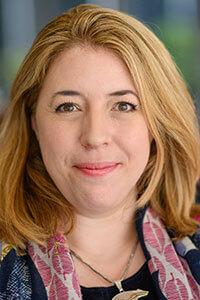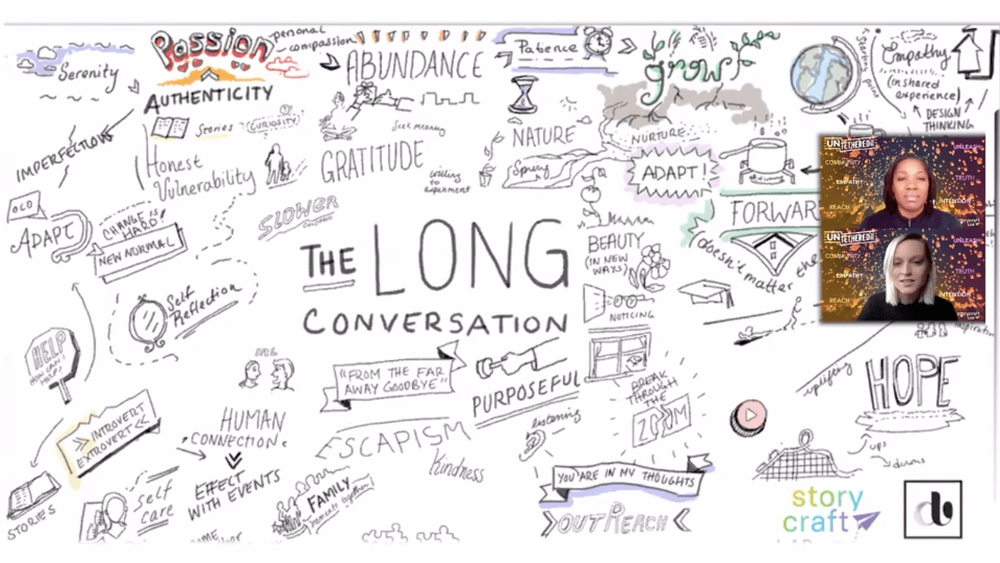
During the Untethered event for events professionals, participants took part in an “idea jam” brainstorming session with NASA and Storycraft Lab. A video recap of the Untethered experience appears at the end of this story.
Naomi Clare has a portfolio filled with immersive events, ones where she and her team at Washington, D.C.–based experience design agency Storycraft Lab orchestrated the movement of people through spaces filled with light, texture, and conversation. Clare, a graduate of the Rhode Island School of Design (RISD) and Storycraft Lab founder, acknowledges the challenges that the current moment is bringing to experience designers. “We’re creative souls when it comes to thinking about experiences,” she said, “and we’re very used to — in the physical world — understanding how we can customize and get creative and be expressive.”
But Clare also is inspired by the potential of the digital and hybrid experience. Since May, Storycraft Lab has hosted a podcast series of think-tank-style conversations called Futures Forum. During the sessions, Clare, a proponent of human-centered design, leads her team and assorted panelists through “idea jams,” where they collaboratively imagine how technology and design can be used to infuse digital and hybrid events with connection and emotional relevance.

Storybook Labs uses visual notetaking during some of its Futures Forum conversations online.
‘A Huge Call to Planners’
In the post-pandemic world, “the challenge is to take the same level of thinking that we always held around experiential engagement and apply it now to the virtual space,” Clare said. “I use the questions that I would ask myself about a live experience: Who am I talking to? Who are we teaching? Who we engaging? What are the tools at my disposal? What’s in the room? And what is it that they, our learners, will take away?”

Naomi Clare
Along with upending the events world, the rapid shift to digital is creating changes in participants’ perspectives, she said. “My hypothesis is that in this current environment, we as audiences are seeing so much value from digital experiences that we’re signing up for.” Events, she added, “are finding new audiences in an unprecedented way, because of how we’re extending inclusion and accessibility.”
Clare also sees value in prerecorded shorter segments. Twenty-five-minute-long presentations are “a wonderful resource that people can tap into anytime,” she said. “But I think that we can’t allow it just to stop there — it’s also a huge call to the planners and strategists out there to think about the value of these content-delivery sessions, and how do we offer variety and engagement in terms of formats. I don’t think people will be satisfied anymore with everybody in a room theater-style for 45 minutes. I think that we’ve actually opened up a whole world of opportunity and possibility when it comes to digging into content delivery and engagement.
“Thank goodness for technology and that it functions in the way that it does, because it’s allowed us to be connected,” she said. “But I think what I fall back on is my passion for teaching and learning and understanding that we all learn differently and we all engage differently. So how do we use the tools that are available to us to provide sessions that are stimulating, provide opportunities for visual learners to engage, for oral conversation to happen, for some notetaking …. allowing people to get hands-on? It’s just a case of, again, getting creative with the tools at our disposal.
“And that’s what I think is the next level for learning in the virtual world — what are those activation exercises?” she said. “There are people who would love to workshop in a group setting and there are people who might like to follow up on a prerecorded session by being part of a study group, where you watch prerecorded presentations, and then get together with a group over a cup of coffee, and chat about what you learned and what your takeaways are.”
In their work for clients, Storycraft Lab has created a series of formats adapted for physical, digital, and hybrid environments. Here are two Clare shared with Convene.

Storycraft Lab designed one of its meeting formats, the Long Conversation, for Untethered, a virtual conference for events professionals in May. The conversation was illustrated live in the main Zoom panel.
The Long Conversation
In 2018, Storycraft Lab designed a “Long Conversation” for the Smithsonian Institution, which, over the course of eight hours, brought together celebrities, academics, poets, citizens, and others — 50 speakers curated in advance — who were paired up to answer a single question. Clare called it “a beautiful mashup of different perspectives.”
To adapt the Long Conversation to Zoom, Clare advises shortening the length to 60-90 minutes. All attendees enter with video and audio off. A moderator opens the session, introducing and posing a question to Conversationalist A, who turns on video and audio. The moderator departs, and then the next conversation partner — Conversationalist B — turns on their audio and video. Conversationalist A then asks Conversationalist B the same question and, after hearing the answer, Conversationalist A departs. Conversationalist C joins the conversation by turning on their audio and video and Conversationalist B asks them the question — and so on.
Participants indicate to the moderator, via chat, that they are willing to talk. It’s a good idea to have curated contributors on standby, in case the conversation lags, Clare said, but putting participants together randomly in a kind of “chat roulette” also serves as an informal networking exercise. The digital sessions also benefit visually from adding live illustration, Clare said — when Storycraft Lab designed a Long Conversation for Untethered, a virtual conference for events professionals in May, the conversation was illustrated live in the main Zoom panel.
To adapt for a hybrid session, organizers could use a small stage with a big screen, where digital participants could appear, or conduct the Long Conversation in a lounge setting with a “silent disco” approach, with both in-person and digital attendees using earbuds and their device.
Lightning Talks
At in-person events, 30-60 minutes is usually allotted to a round of lightning talks, allowing for up to 12 speakers to be heard. Presenters might be asked to tell a story — either their own or someone else’s — and share a single image. Because lightning talks are brief, they require speakers to make their point succinctly and be very intentional about how a single image supports a talking point, which, in turn, helps keep the attention of the audience. It also means many ideas can be presented in a short amount of time.
In hybrid or virtual scenarios, lightning talks — shortened to one-minute videos — are ideal as a way to create “in-demand’ content, Clare said. The recorded talks can be provided as “standalone snackable content bites” that are easy to access and digest. Organizers can group lightning talks into themes or related topics.
In formats like the Long Conversation, organizers have to be comfortable providing support in making connections, and then stepping away from controlling the script, Clare said. “You can plan the arc of the conversation to ensure that important talking points are delivered,” she said, but “there’s huge value in allowing the audience to make that conversation what they need it to be for them, whether that is … an emotional discussion or a thought leadership topic.”
It can be an opportunity for a planner “to sit back in this grand experiment and learn from your audience what is getting them excited and what is really engaging and resonating with them,” she said. And as conference organizers and planners, “it’s okay to plan for how you’re emotionally going to engage and connect with your audience with empathy, and to give them something that is delightful and surprising. That’s what we all need emotionally right now — we need to be connected.”
Barbara Palmer is deputy editor of Convene.
